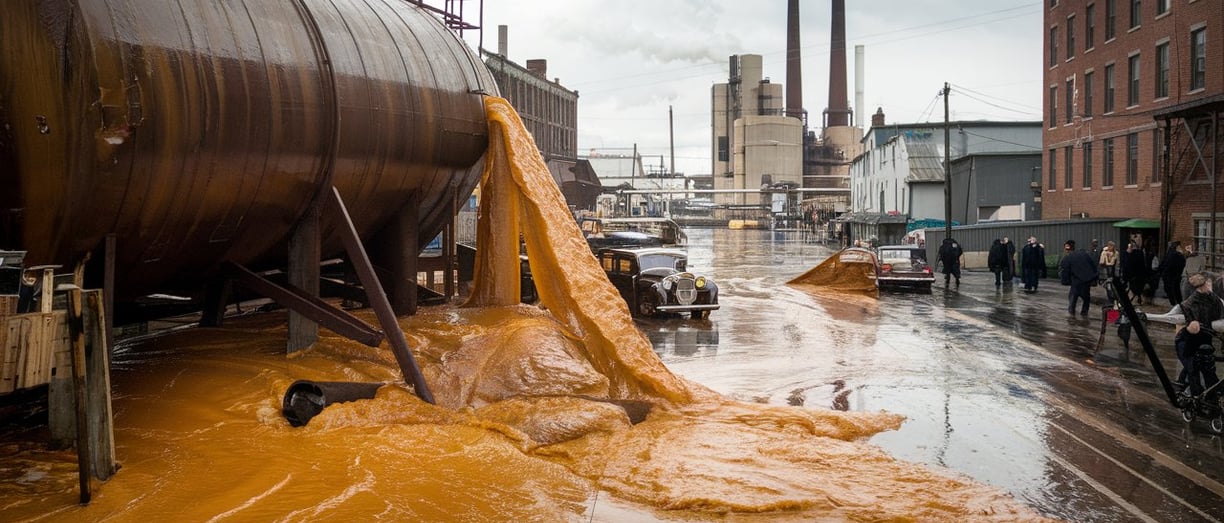The Great Molasses Flood of 1919: A Strange Historical Disaster
5/8/20243 min read


The Great Molasses Flood of 1919 stands out as one of the most peculiar and tragic disasters in American history. On January 15, 1919, a massive wave of molasses swept through the streets of Boston, Massachusetts, claiming lives and causing significant damage. This bizarre event not only shocked the local community but also led to changes in industrial safety regulations. In this comprehensive overview, we’ll explore the origins, key events, and lasting impact of the Great Molasses Flood.
Origins of the Disaster
The disaster occurred in Boston’s North End, an area that was bustling with industry and a large immigrant population. The flood was caused by the rupture of a massive molasses storage tank owned by the Purity Distilling Company. This tank, standing 50 feet tall and 90 feet in diameter, was used to store molasses, which was a common ingredient in the production of industrial alcohol.
The Purity Distilling Company had been storing molasses in this tank for several years. However, the tank was poorly constructed, with numerous reports of its instability and leaks. The construction materials used were substandard, and there were concerns about the tank’s ability to withstand the pressures of the molasses. Moreover, the company had failed to maintain the tank adequately, ignoring the necessary safety inspections and repairs.
The Day of the Flood
On the fateful day of January 15, 1919, the temperature in Boston was unseasonably warm, causing the molasses to become more fluid and increase the pressure within the tank. At approximately 12:30 p.m., the tank burst with a thunderous roar, releasing an enormous wave of molasses that rushed through the streets at speeds of up to 35 miles per hour.
The molasses wave was a force to be reckoned with. It reached heights of up to 25 feet in some areas, overwhelming buildings, railcars, and everything in its path. The flood of molasses swept through the North End, flooding streets and causing significant destruction. The thick, sticky substance coated buildings, vehicles, and people, creating a scene of chaos and devastation.
Immediate Aftermath
The immediate aftermath of the flood was both tragic and surreal. The molasses wave caused the deaths of 21 people and injured over 150 others. Many of the victims were trapped under the viscous mass of molasses, making rescue efforts extremely challenging. Firefighters and emergency responders struggled to reach those in need as they battled the sticky, treacherous substance.
In addition to the loss of life, the flood caused extensive damage to infrastructure. Buildings were damaged or destroyed, and railways were rendered impassable. The cleanup efforts were monumental, as crews worked to remove the molasses from the streets and buildings. The cleanup operation took weeks, with large amounts of molasses being removed by using salt water and even attempts to employ horses and steam shovels.
Legal and Social Implications
The Great Molasses Flood had significant legal and social consequences. In the aftermath of the disaster, a series of lawsuits were filed against the Purity Distilling Company. The company was held responsible for the inadequate construction and maintenance of the tank. The legal proceedings revealed numerous safety violations and the company’s negligence in addressing the tank’s issues.
The flood also highlighted the need for stricter industrial safety regulations. The disaster served as a wake-up call for both the public and the government regarding the importance of maintaining safe industrial practices. It led to increased scrutiny of industrial facilities and the implementation of new safety standards to prevent similar tragedies in the future.
In addition to its impact on industrial safety, the Great Molasses Flood became a part of local lore and cultural history. The disaster’s unusual nature and the images of a city inundated with molasses left a lasting impression on the collective memory of Boston’s residents. The event has been commemorated in various ways, including historical accounts, museum exhibits, and local folklore.
Legacy and Reflection
The Great Molasses Flood of 1919 remains a unique and haunting chapter in American history. While the event may seem odd in retrospect, it underscores the importance of industrial safety and the potential consequences of neglect. The disaster’s legacy serves as a reminder of the need for vigilance in maintaining and regulating industrial practices to ensure the safety of communities.
In popular culture, the Great Molasses Flood has been referenced in various media, highlighting its enduring impact on the collective consciousness. The event serves as a poignant example of how seemingly mundane substances can become instruments of disaster under certain conditions.
In conclusion, the Great Molasses Flood of 1919 is a stark reminder of the unexpected and sometimes bizarre nature of disasters. Its impact on Boston and the broader field of industrial safety continues to be remembered and studied. This strange and tragic event not only reshaped the city’s landscape but also contributed to a legacy of improved safety standards and a deeper understanding of the potential risks associated with industrial operations.
Explore
Uncovering hidden stories from the past.
Connect
Discover
© 2024. All rights reserved. The Unseen History logo is registered trademark.
